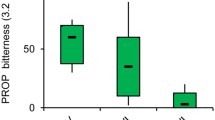Abstract
The aim of our study was to study gustatory function in a large portion of the general population using liquid tastants, extending previous research. Further, we investigated the test–retest reliability of the test used. Data from 944 healthy subjects were used (498 women and 446 men, mean age 45 years; age range 5–90 years). For lateralized assessment of gustatory function, liquid taste solutions were used with different concentrations of each tastant (sweet 0.03, 0.1, 0.4, 2 g/mL sucrose solution; sour 0.01, 0.05, 0.1, 0.15 mL citric acid; salty 0.025, 0.075, 0.15, 0.36 mL sodium chloride solution; bitter 0.0002, 0.0005, 0.001, 0.01 mL quinine hydrochloride). A drop (approximately 20 µL) of liquid tastant was applied on the right side or on the left side of the anterior/posterior third of the extended tongue. The taste test had a good test–retest reliability r 304 = 0.78 (P < 0.001) for the total score and r 304 = 0.77 (P < 0.001) for the right-sided measures and r 304 = 0.75 (P < 0.001) for the left-sided measures, respectively. Gustatory sensitivity was found to decrease with age; women were more sensitive to gustatory stimuli than men. Irrespective of the sex-related differences, the total score at the 10th percentile was 28 in subjects younger than 15 years, 26.1 for ages from 16 to 35 years, 25 for ages from 36 to 55 years, and 24 for subjects older than 56 years of age. In conclusion, this test is recommended for clinical assessment of the ability to taste. The test provides reliable data, which is easy to handle, inexpensive, timesaving and can be self-made.





Similar content being viewed by others
References
(1980) Communication. Working group for “clinical olfactology and gustology”. Recommendations for assessments of the sense of smell and taste. HNO-Praxis 5:62–67
Ahne G, Erras A, Hummel T, Kobal G (2000) Assessment of gustatory function by means of tasting tablets. Laryngoscope 110:1396–1401
Bartoshuk L (1989) Clinical evaluation of the sense of taste. Ear Nose Throat 68:331–337
Chandrashekar J, Hoon MA, Ryba NJ, Zuker CS (2006) The receptors and cells for mammalian taste. Nature 444:288–294
Doty RL, Shaman P, Dann M (1984) Development of the University of Pennsylvania Smell Identification Test: a standardized microencapsulated test of olfactory function. Physiol Behav 32:489–502
Fukunaga A, Uematsu H, Sugimoto K (2005) Influences of aging on taste perception and oral somatic sensation. J Gerontol A Biol Sci Med Sci 60:109–113
Gudziol H, Hummel T (2007) Normative values for the assessment of gustatory function using liquid tastants. Acta Otolarnygol 127:658–661
Hummel T, Erras A, Kobal G (1997) A test for screening of taste function. Rhinology 35:146–148
Just T, Homoth J, Graumüller S, Pau HW (2003) Taste disorders and recovery of the taste function after middle ear surgery. Laryngorhinootologie 82:494–500
Kobal G, Klimek L, Wolfensberger M, Gudziol H, Temmel A, Owen CM, Seeber H, Pauli E, Hummel T (2000) Multicenter investigation of 1,036 subjects using a standardized method for the assessment of olfactory function combining tests of odor identification, odor discrimination, and odor thresholds. Eur Arch Otorhinolaryngol 257:205–211
Krarup B (1959) Electrogustometry: a new method for clinical taste examination. Acta Otolaryngol 49:294–395
Landis BN, Welge-Luessen A, Bramerson A, Bende M, Mueller CA, Nordin S, Hummel T (2009) “Taste Strips”—a rapid, lateralized, gustatory bedside identification test based on impregnated filter papers. J Neurol 256:242–248
Matsuda T, Doty R (1995) Regional taste sensitivity to NACL: relationship to subject age, tongue locus and area of stimulation. Chem Senses 20:283–290
Mueller C, Kallert S, Renner B, Stiassny K, Temmel AF, Hummel T, Kobal G (2003) Quantitative assessment of gustatory function in a clinical context using impregnated “taste strips”. Rhinology 41:2–6
Murphy C, Quinonez C, Nordin S (1995) Reliability and validity of electrogustometry and its application to young and elderly persons. Chem Senses 20:499–503
Nordin S, Bramerson A, Bringlov E, Kobal G, Hummel T, Bende M (2007) Substance and tongue-region specific loss in basic taste-quality identification in elderly adults. Eur Arch Otorhinolaryngol 264:285–289
Tomita H, Ikeda M (2002) Clinical use of electrogustometry: strengths and limitations. Acta Otolaryngol Suppl 27–38
Tomita H, Ikeda M, Okuda Y (1986) Basis and practice of clinical taste examinations. Auris Nasus Larynx 13 (Suppl 1)
Author information
Authors and Affiliations
Corresponding author
Rights and permissions
About this article
Cite this article
Pingel, J., Ostwald, J., Pau, H.W. et al. Normative data for a solution-based taste test. Eur Arch Otorhinolaryngol 267, 1911–1917 (2010). https://doi.org/10.1007/s00405-010-1276-1
Received:
Accepted:
Published:
Issue Date:
DOI: https://doi.org/10.1007/s00405-010-1276-1




